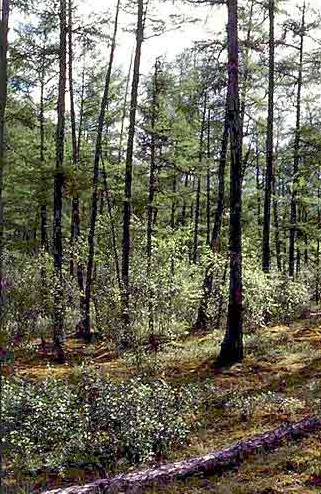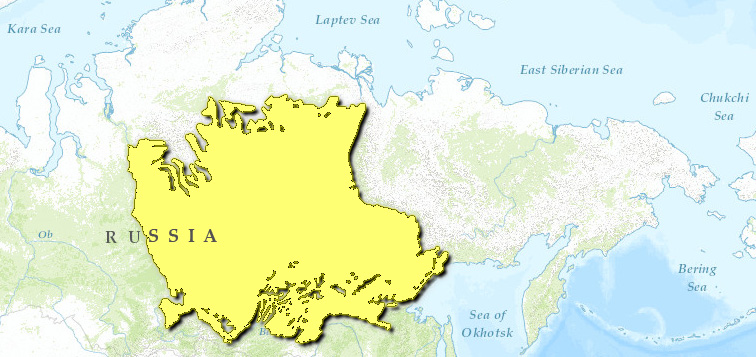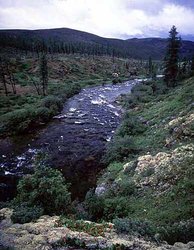East Siberian taiga

Polovinnaya Pad' Valley, Uryupino, Chita Province, Russia. (Photograph by O. Kosterin)
Introduction This ecoregion (East Siberian taiga) is vast, spanning over 20 degrees of latitude and 50 degrees of longitude. It represents one of the most extensive natural forests left in the world. Larch forests dominate the region as they are able to withstand the extreme climate conditions. The diversity of this taiga is not fully represented in the protected area network.
Location and General Description
The ecoregion is a vast and geographically diverse area between the Yenisei River and Lena River. Its northern border reaches the Arctic Circle, and its southern border reaches 52°N latitude. The maximum width from north-to-south is 1,600 kilometers (km). The eastern Siberian taiga is considered the heart of Siberia because most of the typical Siberian species are best represented there.
The climate is strongly continental, reaching its extremes in the region's northeast. The anticyclone eferencesweather dominates most of the year. The summer is very hot (up to +40° Celcius (C)) and winter is bitterly cold (down to -62°C in Central Yakutia), but snow cover is only moderate or thin. The average annual temperature is below freezing. All this leads to the preservation of permafrost, which is a major factor for the distribution of vegetation and many environmental processes. Annual precipitation ranges from 400 to 600 millimeters (mm) in the western part, gradually decreasing to 200 mm eastward.
The orogenic structure is complicated. Most of the ecoregion is located on the Siberian Precambrian platform. In Central Yakutia, there are thick alluvial deposits forming extensive plains. On the Sredenesibirskoye Ploskogorye (high Central Siberian plateau) there are intensive karst processes. The ecoregion is very rich in mineral resources. The eastern Siberian taiga has an extensive river network. The base of this network are the larger tributaries of the Enisey River, such as the Angara, Podkamennaya Tunguska and Nizhnyaya Tunguska, as well as those of the Lena River, such as the Bilyuy, Vitim, and Aldan. The dominant vegetation formation is light coniferous taiga with Larix gmelini forming the canopy in areas with low snow cover. This formation occupies more area than any other forest formation in Russia. Towards the west , two other species of larch occur: Larix sibirica and hybrid L. x czekanowskii. The dark coniferous taiga is distributed in mosaiclike patterns in the more-protected positions of landscape, with Pinus sibirica, Picea obovata and Abies sibirica dominating. Toward the south, the proportion of pine-larch and pine forests increases, and small leaf forests with Betula and Populus begin to appear. Grass and dwarf shrub-grass as well as stepped pine and pine-larch forests are common in the basin of the Angara River and the headwaters of the Lena and Nizhnyaya Tunguska Rivers. Gradually, this community tapers out towards Central Yakutia. A characteristic feature of the east Siberian taiga is the absence of large bogs and swamps.
Biodiversity Features
The flora and fauna of the eastern Siberian taiga is significantly richer than those of the western Siberian taiga. There are many endemics at the species and genus levels of various taxa. Central Yakutia can be considered one of the endemism centers in Siberia. The flora of eastern Siberia (including the mountains) consists of more than 2,300 species. Flora of vascular plants of Central Siberian plateau include 1010 species. More than 650 species have been found in Olekminskij Zapovednik. Endemics of Cental Yakutia include: Adenophora jacutica and Polygonum amgense. Other endemics of eastern Siberia are: Megadenia bardunovii, Oxytropis calva, O. leucantha, Viola alexandroviana, Senecio lenensis, Salix saposhnikovii, Juncus longirostris, Gastrolychnis angustifolia ssp. tenella, Caltha serotina, Papaver variegatum, Draba sambykii, Thymus evenkiensis, Potentilla jacutica, Artemisia czekanowskiana. Nationally endangered plant species (15 species in total) include: Cypripedium macranthon, Calypso bulbosa, Orchis militaris and Cotoneaster lucidus.
The fauna of the eastern Siberian taiga is considerably older than that of the western Siberia taiga. The Enisey River is an important zoogeographical border because many taiga animal species occur only to its east. These species include: Moschus moschiferus, Apodemus speciosus, Luscinia cyane, L. sibilans, Carpodacus roseus, Apus pacificus, Streptopelia orientalis, Tetrao parvirostris, Anas formosa and Corvus corone. Species that do not cross the river from the west include: Gallinago megala, Acrocephalus schoenobaenus, Fringilla coelebs, Luscinia luscinia, Corvus corone cornix. In relation to the western Siberia taiga, the eastern Siberian taiga has a much denser population of hoofed animals, such as: Alces alces, Capreolus capreolus, Sus scrofa and Cervus elaphus. The total number of vertebrate species is high. In Krasnoyarsky Krai, which constitutes only part of the ecoregion, there are 4 species of amphibians, 2 species of reptiles, 203 species of birds and about 80 mammals. The Enisey River and its tributaries contain 42 species of fish. There are 11 nationally threatened vertebrate species, including Aquila chrysaetos, Pandion haliaetus, Falco peregrinus, Ciconia nigra and Grus monacha.
Current Status
The eastern Siberian taiga still preserves vast pristine habitats, probably one of the most extensive in the world. Only a fraction of them are located in protected areas. These include the zapovedniks of Stolby, Olekminskij, Tugusskij, Tsentralno-sibirskij (Eniseisko-Stolbovoy uchastok), Lenskie Stolby National Park and numerous nature monuments. Nevertheless, the existing network of protected areas is not sufficient for such an extensive region. The diversity of the taiga ecosystem is not completely represented, and protected areas are located far apart.
The following plant associations need priority protection: Pinus sylvestris-Duschekia fruticosa-Vaccinium vitis-idaea+Scorzonera radiata+Limnas stelleri, Pinus sylvestris-Sobcotoneaster pozdnjakovii-Dryas viscosa+Carex pediformis, Picea ajanensis-Pinus pumila-Diplazium sibiricum+Pyrola incarnata+Vaccinium vitis-idaea-Hylocomium splendens, Pinus sylvestris-Pinus pumila-Cladina stellaris+Cl.rangiferina, Pinus sylvestris-Arctostaphyllos uva-ursi+Pulsatilla flavescens.
Types and Severity of Threats
The main threats are widespread forest fires, intensive clear-cuts in the central and southern taiga subzones and poaching.
Justification of Ecoregion Delineation
This ecoregion lies in between the Yenisei River and the Verkhoyansk Mountains in Russia. Larch forests dominate the region as they are able to withstand the extreme continental climate and dry winters. The abundant mires of Western Siberia are replaced by drier ground with scrub-alder undergrowth. The fauna is believed to have developed earlier here than in Western Siberia. The ecoregion boundary corresponds to the central and sparse forest taiga in the Central Siberian forest province and the East Siberian forest province west of the Dzhugzhur Mountains in Kurnaev's forest map of the USSR. A section of Kurnaev's West Siberian province is also included to conform to the more standard convention of using the Yenisei River as a biogeographic boundary.
Additional information on this ecoregion
- For a shorter summary of this entry, see the WWF WildWorld profile of this ecoregion.
- To see the species that live in this ecoregion, including images and threat levels, see the WWF Wildfinder description of this ecoregion.
- World Wildlife Fund Homepage
Further Reading
- Abaimov, A. P., J. A. Lesinski, O. Martinsson, and L. I. Milyutin. 1998. Variability and ecology of Siberian larch species. Swedish University of Agricultural Sciences. Department of Silviculture. Report 43.
- Goljakov, P. V. 1994. Sosudistye rastenia Olekminskogo zapovednika. Plant of Olekinskij Zapovednik. Annotirovannyj spisok vidov. Flora and fauna of zapovednikov. Vol. 54. Nauka, Moscow.
- Kurnaev, S. 1990. Forest regionalization of the USSR (1:16,000,000). Department of Geodesy and Cartography, Moscow.
- Malyshev, L. I., G. A. Peshkova. 1979. Nuzhdajutsja v ohrane redkie I ischezajushe rastenuja Tsentral'noj Sibiri. Plants of Central Siberia. Nauka, Novosibirsk.
- Parmuzin, Y. P. 1985. Taiga SSSR. Of the USSR Mysl'., Moscow.
- Pavlov, D. S., V. J. Sokolov, and J. J. Syroechkovskij. editors. 1999. Zapovedniki Sibiri. Of Siberia. LOGATA, Moscow. ISBN: 5900858235
- Rogacheva, E. V. 1992. The birds of Central Siberia. Husum Druck-Verlag. Husum.
- Vodop'yanova, N. S. 1984. Zonal'nost flori Srednesibirskogo ploskogor'ya. Of Central Siberian flora. Novosibirsk, "Nauka".
- Zabelina, N. M., L. S. Isaeva-Petrova, and L. V. Kuleshova. 1998. Zapovedniki I natsional'nye parki Rossii. And national parks of Russia. LOGATA, Moscow.
- Zelenaja kniga Sibiri. Redkie I nuzhdajushiesja v ohrane rastitel'nye soobshestvsa. Book of Siberia. Rare and endangered plant communities. Nauka, Novosibirsk. 1996.
| Disclaimer: This article is taken wholly from, or contains information that was originally published by, the World Wildlife Fund. Topic editors and authors for the Encyclopedia of Earth may have edited its content or added new information. The use of information from the World Wildlife Fund should not be construed as support for or endorsement by that organization for any new information added by EoE personnel, or for any editing of the original content. |

%2c_Baikalo-Lensky_Zapovednik%2c_northwest_of_Lake_Baikal%2c_Russia.jpg)

%2c_Olekminsky_Zapovednik%2c_northeast_of_Lake_Baikal%2c_Russia.jpg)